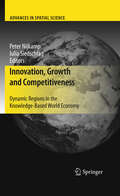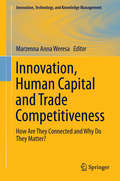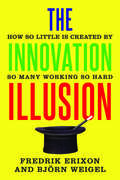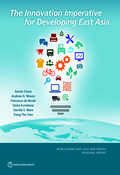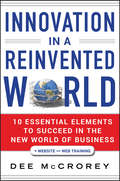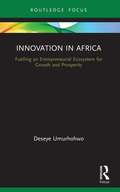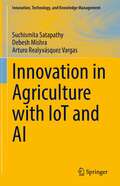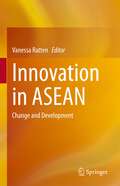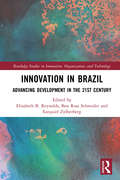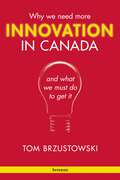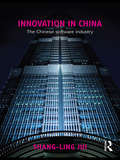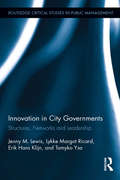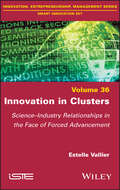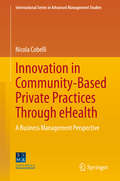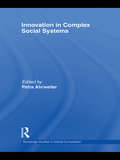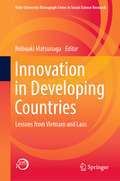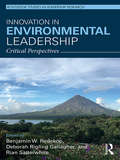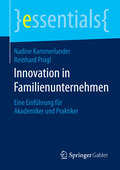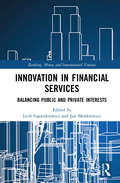- Table View
- List View
Innovation, Growth and Competitiveness
by Peter Nijkamp Iulia SiedschlagThis book investigates dynamic regions in the context of greater global interaction in a world economy increasingly driven by knowledge and innovation. It offers novel empirical evidence on the underlying factors of the growth performance of these spaces. In particular, the following questions are addressed: What role is there for research, education and innovation in the development strategies of the dynamic growth regions? What are the risks and consequences of dynamic growth on patterns of world growth and development, competitiveness, inequalities, and convergence? What development strategies should be promoted at national and international levels to promote a growing and more sustainable world economy? What are the implications of the emerging new competitors for Europe's competitiveness? Using an innovative, integrated framework of analysis, the contributions in this book combine a wide array of complex theoretical and methodological approaches.
Innovation, Human Capital and Trade Competitiveness
by Marzenna Anna WeresaThis work focuses on researching and establishing the importance of human capital and innovation as determinants of competitive advantages in international trade--in the context of rapidly evolving technological advancement, globalization, and economic integration. The processes that accompany the shift from industrial economics to a knowledge-based economy are currently the object of interest of both scientists, politicians, investors and entrepreneurs. In many countries, the traditional sources of socioeconomic development, such as low labor costs, availability of inexpensive raw materials, and favorable geographic location are waning. These economies are searching for new sources of competitive advantage that will allow for maintaining growth, among other things by boosting participation in international trade. The book explores non-traditional drivers of competitiveness in both theory and practice. First, chapters 1 through 4 present theoretical and methodological aspects of the relationships among international trade, human capital and innovation. Here the authors address the controversy associated with the concept of competitiveness itself and its measurement, while paying special attention to the political development of comparative advantages related to international trade. The second part of the monograph, chapters 5 through 8, is of empirical nature. This section contains case studies of selected countries that represent models of various national innovation systems. Finally, the theoretical and practical aspects are integrated, allowing policymakers and financial and business leaders to consider how their decisions can influence their countries' competitive positions through their investments in innovation and human capital.
The Innovation Illusion: How So Little Is Created by So Many Working So Hard
by Björn Weigel Fredrik ErixonTimely, compelling, and certain to be controversial--a deeply researched study that reveals how companies and policy makers are hindering innovation-led growth Conventional wisdom holds that Western economies are on the threshold of fast-and-furious technological development. Fredrik Erixon and Bjorn Weigel refute this idea, bringing together a vast array of data and case studies to tell a very different story. With expertise spanning academia and the business world, Erixon and Weigel illustrate how innovation is being hampered by existing government regulations and corporate practices. Capitalism, they argue, has lost its mojo. Assessing the experiences of global companies, including Nokia, Uber, IBM, and Apple, the authors explore three key themes: declining economic dynamism in Western economies; growing corporate reluctance to contest markets and innovate; and excessive regulation limiting the diffusion of innovation. At a time of low growth, high unemployment, and increasing income inequality, innovation-led growth is more necessary than ever. This book unequivocally details the obstacles hindering our future prosperity.
The Innovation Imperative for Developing East Asia (World Bank East Asia and Pacific Regional Report)
by Xavier Cirera Andrew D. Mason Francesca de Nicola Kuriakose Trang Thu TranAfter a half century of transformative economic progress that moved hundreds of millions of people out of poverty, countries in developing East Asia are facing an array of challenges to their future development. Slowed productivity growth, increased fragility of the global trading system, and rapid changes in technology are all threatening export-oriented, labor-intensive manufacturing—the region’s engine of growth. Significant global challenges—such as climate change and the COVID-19 pandemic—are exacerbating economic vulnerability. These developments raise questions about whether the region’s past model of development can continue to deliver rapid growth and poverty reduction. Against this background, The Innovation Imperative in Developing East Asia aims to deepen understanding of the role of innovation in future development. The report examines the state of innovation in the region and analyzes the main constraints that firms and countries face to innovating. It assesses current policies and institutions, and lays out an agenda for action to spur more innovation-led growth. A key finding of the report is that countries’ current innovation policies are not aligned with their capabilities and needs. Policies need to strengthen the capacity of firms to innovate and support technological diffusion rather than just invention. Policy makers also need to eliminate policy biases against innovation in services, a sector that is growing in economic importance. Moreover, countries need to strengthen key complementary factors for innovation, including firms’ managerial quality, workers’ skills, and finance for innovation. Countries in developing East Asia would also do well to deepen their tradition of international openness, which could foster openness in other parts of the world. Doing so would help sustain the flows of ideas, trade, investment, and people that facilitate the creation and diffusion of knowledge for innovation.
Innovation in a Reinvented World
by Dee MccroreyA step-by-step guide to the 10 essential and practical skills a business needs to innovate and thrive in uncertain times The reinvented world of business will profoundly impact America's leaders and workers in the decade ahead. Companies capable of transforming their organizations during this period of "Great Disruption" will thrive in the reinvented world however, the reverse holds true as well. Innovation in a Reinvented World reveals how transformation occurs when business leaders and their organizations apply these 10 Essential Elements, providing both a road map and definitive blueprint for companies of any size looking to bridge the old world with the new world of business. Discusses the "new courage" required for innovating in a reinvented world Looks at 10 Essential Elements winning companies count on today Innovation in a Reinvented World helps executives and leadership teams navigate and manage their organizations' inflection points in designing, building, and sustaining innovation--even through the post-recession playing field.
Innovation in Africa: Fuelling an Entrepreneurial Ecosystem for Growth and Prosperity (Routledge Focus on Business and Management)
by Deseye UmurhohwoThis book emphasizes the need for promoting innovation on the African continent. It identifies the roadblocks for entrepreneurs and discusses ways for developing an ecosystem for innovators to pave a way through the barriers and create ground-breaking products and new technologies which meet consumers’ needs in Africa. In order to stimulate innovation in African countries, there is the need for a more appropriate approach for innovation to occur in a context of international openness to knowledge. This book adopts a practical approach, demonstrating how innovation is an important driver of economic growth and competitiveness. It shows that innovation in Africa should be driven by local people, in response to local problems, and that open technology and knowledge sharing are vital to this project. It further explores key enablers such as the discovery of innovative talent, overcoming barriers, building strategic partnerships and promoting innovation across the continent. The book places emphasis on the creation of an innovation ecosystem as a value-creating tool by stakeholders for nation building and growth in Africa. This book will be of interest to researchers, students, international agencies, governments, businesses and individuals interested in the field of innovation and its potentials. It will also be relevant to investors, manufacturers and other stakeholders involved in the economic development of Africa.
Innovation in Agriculture with IoT and AI (Innovation, Technology, and Knowledge Management)
by Suchismita Satapathy Debesh Mishra Arturo Realyvásquez VargasThis book examines different innovations in worldwide agricultural-systems including the applications of artificial intelligence (AI), internet of things (IoT) and features of machine learning (ML) for the benefits of the farm-community. Specifically, it examines the use of agricultural equipment and IoT to reduce physical stress; innovative equipment that measure and reduce mental work load; and innovative techniques to help with employee safety. Featuring case studies and future implications, this book is an excellent guide for academics and researchers in the agri-sector.
Innovation in Architecture: A Path to the Future
by Alan J. Brookes Dominique PooleIn this highly original book, through a series of essays, key architects and engineers in Europe, Australia, and the USA describe the ideas and development behind the innovative technology in their chosen projects, with the emphasis being on the means of production and the links between design and the manufacturing process.
Innovation in ASEAN: Change and Development
by Vanessa RattenThis book focuses on innovation in the ASEAN such as Brunei, Indonesia, Malaysia andSingapore to demonstrate that it is contextually different to other geographic regionsdue to the climate, government structure and history. This book shows that innovationdevelops based on cultural and societal conditions.The aim of this book is to focus on how innovation occurs in Brunei, Indonesia,Malaysia and Singapore. Thereby focusing on the unique country elements of eachcountry but also exploring the integrated history of these countries. The book highlightsthese countries together due to Brunei and Singapore previously being part of Malaysiaand the fact that they are in close geographic proximity. In addition, this book statesthat all countries share the same language (Bahasa Indonesia or Malay), which is acommon cultural feature of these countries. In this book chapters focus on differentforms of innovation from social to technological. Thereby offering a holistic perspectiveabout how innovation occurs within and between these countries.
Innovation in Banking and Excessive Loan Growth
by Daniel C. Hardy Alexander F. TiemanA report from the International Monetary Fund.
Innovation in Branding and Advertising Communication (Routledge Research in Communication Studies)
by Lluís Mas-ManchónThis book addresses innovative and new aspects of branding and advertising communication, by drawing on a broad, interdisciplinary range of theories, methods and techniques– from body image, identity and mental imagery, to self-exposure and LCM4P – intersecting with branding and advertising constructs and practices. The editor combines the perspectives of an international group of scholars to establish new theoretical frameworks and proposes new methodological designs to conduct comprehensive studies in the field. Situated at the intersection between society, communication and psychology, each chapter presents an innovative approach to branding and advertising research. The book explores topics such as social robots, body image in video advertising, brand personality, transmedia personal brands, erotic content in commercial images, and brand fandom communities. Innovation in Advertising and Branding Communication will be a valuable resource for scholars working in the fields of marketing communication, branding and advertising, online communication, sociology, social psychology and linguistics
Innovation in Brazil: Advancing Development in the 21st Century (Routledge Studies in Innovation, Organizations and Technology)
by Ben Ross Schneider Elisabeth B. Reynolds Ezequiel ZylberbergSince the early 2000s, state-led and innovation-focused strategies have characterized the approach to development pursued in countries around the world, such as China, India, and South Korea. Brazil, the largest and most industrialized economy in Latin America, demonstrates both the opportunities and challenges of this approach. Over the course of nearly 20 years, the Brazilian government enacted various policies and programs designed to strengthen the country’s capacity to innovate. It increased spending on science and technology, encouraged greater collaboration between industry and universities, and fostered the creation of new institutions whose primary aim was to facilitate greater private research and development (R&D) spending. In this book, the editors unite a diverse array of empirical contributions around a few key themes, including public policies, institutions and innovation ecosystems, and firms and industries, that collectively make the case for a new, forward-looking innovation agenda aimed at addressing persistent challenges and exploiting emerging opportunities in Brazil. Its conclusions offer valuable lessons for other developing and emerging economies seeking to accelerate innovation and growth in the modern age. With its interdisciplinary and wide-ranging contribution to the study of innovation, as well as attention to broader policy implications, this book will appeal to scholars and professionals alike.
Innovation in Business Education in Emerging Markets
by Ilan Alon Victoria Jones John R. McintyreEmerging market economies account for eighty percent of the world's population and some 75% of its trade growth in the foreseeable future, following US Department of Commerce data. This volume provides insights for success in rapidly growing education markets that can be used by educators, administrators, policy makers and planners.
Innovation in Canada: Why We Need More and What We Must Do to Get It
by Thomas BrzustowskiCanada has a prosperity problem because we don t create enough wealth. Business as usual is not a solution; we need to create more value in new ways - that s innovation. But beyond innovation to solve our current problems, we must learn how to innovate in new ways to deal with whatever future pressures and opportunities arise from global demographics and climate change. Innovation in Canada demystifies innovation and presents its many aspects in one big picture. The book proposes innovation in both goods and services as the means for increasing the value of what the Canadian economy produces. This will raise our prosperity and show up as improved productivity. Written in plain language and illustrated with corporate data, the book underlines the essential roles of technology, entrepreneurship and commerce. It points out important differences between innovation in established firms and innovation in new ventures, whose time scales are shorter and whose needs are more urgent. Innovation in Canada proposes the elements of a supportive government innovation policy, and it outlines the different design principles for government assistance programs needed to provide effective support to the two different groups of innovative companies.
Innovation in Capitalist Economies: Crises, Challenges and Opportunities (Routledge Frontiers of Political Economy)
by Faruk Ülgen Lyubov KlapkivInnovation is critical to increasing global prosperity and also essential to surviving and overcoming the ongoing challenges of pandemics, wars, climate change, and systemic financial turmoil.At the same time, major corporations seek to transform new knowledge and scientific progress into profitable innovations and to increase their influence over society. But if, as these firms claim, this tremendous innovativeness has a positive long-term effect on our lives, who ultimately pays the price for this development? This edited volume tackles issues related to innovation dynamics of modern capitalist economies, exploring the nature, the effects and the dynamics of innovative behaviour and the social impact of related policies. The first part of the book includes chapters on the selected drivers of innovative changes that driven by companies. The focus is made on organizational and financial determinants of innovations as well as on creative communities and social cooperation in networks that promote creative decisions. The second part is devoted to the innovations that play a role in the creation of added value and new financial solutions that allow companies to keep their vitality under the pressure of multiple events such a pandemic, climate policies, or growing geopolitical risk. Together, the contributors explore the various impacts of innovation on the way we are organizing capitalist economies in the 21st century.This book will be of great interest to readers of the political economy of financial and economic development, innovation, banking and finance studies, economic policy, and economic crises.
Innovation in China: The Chinese Software Industry (Routledge Contemporary China Series)
by Shang-Ling JuiA key question for China, which has for some time been a leading global manufacturing base, is whether China can progress from being a traditional centre of manufacturing to becoming a centre for innovation. In this book, Shang-Ling Jui focuses on China’s software industry and examines the complete innovation value chain of software in its key phases of innovation, standards definition, development and marketing. He argues that, except for software development, these key phases are of high added-value and that without adopting the concept of independent innovation as a guiding ideology, China’s software enterprises – like India’s – would have an uncertain future. In other words, the lack of core competence in the development of China’s software industry might restrain the industry from taking the leading position and drive it towards becoming no more than the software workshop of multinationals over the long term. Shang-Ling Jui contends that China’s software industry should and can possess its own complete innovation value chain. Having worked in China’s software industry for many years, the author provides an inside-out perspective – identifying the strengths and weaknesses of the industry and defining the challenges in China’s transition from "Made in China" to "Innovated in China."
Innovation in City Governments: Structures, Networks, and Leadership (Routledge Critical Studies in Public Management)
by Jenny M. Lewis Lykke Margot Ricard Erik Hans Klijn Tamyko Ysa FiguerasInnovation has become an important focus for governments around the world over the last decade, with greater pressure on governments to do more with less, and expanding community expectations. Some are now calling this ‘social innovation’ – innovation that is related to creating new services that have value for stakeholders (such as citizens) in terms of the social and political outcomes they produce. Innovation in City Governments: Structures, Networks, and Leadership establishes an analytical framework of innovation capacity based on three dimensions: Structure - national governance and traditions, the local socioeconomic context, and the municipal structure Networks – interpersonal connections inside and outside the organization Leadership – the qualities and capabilities of senior individuals within the organization. Each of these are analysed using data from a comparative EU research project in Copenhagen, Barcelona and Rotterdam. The book provides major new insights on how structures, networks and leadership in city governments shape the social innovation capacity of cities. It provides ground-breaking analyses of how governance structures and local socio-economic challenges, are related to the innovations introduced by these cities. The volume maps and analyses the social networks of the three cities and examines boundary spanning within and outside of the cities. It also examines what leadership qualities are important for innovation. Innovation in City Governments: Structures, Networks, and Leadership combines an original analytical approach with comparative empirical work, to generate a novel perspective on the social innovation capacity of cities and is critical reading for academics, students and policy makers alike in the fields of Public Management, Public Administration, Local Government, Policy, Innovation and Leadership.
Innovation in Clusters: Science-Industry Relationships in the Face of Forced Advancement
by Estelle VallierForged at the heart of international political bodies by expert researchers, the innovation cluster concept has been incorporated into most public policies in industrialized countries. Based largely on the ideas behind the success of Silicon Valley, several imitative attempts have been made to geographically group laboratories, companies and training in particular fields in order to generate “synergies” between science and industry. In its first part, Innovation in Clusters analyzes the infatuation with the system of clusters that is integral to innovative policies by analyzing its socio historical context, its revival in management and its worldwide expansion, looking at a French example at a local level. In its second part, the book explores a specialized biotechnology cluster dating back to the end of the 1990s. The sociological survey conducted twenty years later sheds a different light on the dynamics and relationships between laboratories and companies, contradicting the commonly held belief that innovation is made possible by geographical proximity.
Innovation in Community-Based Private Practices Through eHealth: A Business Management Perspective (International Series in Advanced Management Studies)
by Nicola CobelliThere are many definitions of eHealth and no consensus around the underlying idea. Most contributions on eHealth focus on informatic, public health, legal, social and anthropological implications. This book investigates eHealth through community-based private practices such as pharmacies, hearing centres, opticians, and private medical centres from a management perspective. It first presents a systematic review of the theoretical research models that have been developed on eHealth. It then identifies the many innovative managerial implications of eHealth, and finally, it analyses reasons why some eHealth tools are or are not adopted.
Innovation in Complex Social Systems (Routledge Studies In Global Competition Ser. #49)
by Petra AhrweilerInnovation is the creation of new, technologically feasible, commercially realisable products and processes and, if things go right, it emerges from the ongoing interaction of innovative organisations such as universities, research institutes, firms, government agencies and venture capitalists. Innovation in Complex Social Systems uses a "hard science" approach to examine innovation in a new way. Its contributors come from a wide variety of backgrounds, including social and natural sciences, computer science, and mathematics. Using cutting-edge methodology, they deal with the complex aspects of socio-economic innovation processes. Its approach opens up a new paradigm for innovation research, making innovation understandable and tractable using tools such as computational network analysis and agent-based simulation. This book of new work combines empirical analysis with a discussion of the tools and methods used to successfully investigate innovation from a range of international experts, and will be of interest to postgraduate students and scholars in economics, social science, innovation research and complexity science.
Innovation in Developing Countries: Lessons from Vietnam and Laos (Kobe University Monograph Series in Social Science Research)
by Nobuaki MatsunagaThe main focus of this book is innovation for developing countries: what is the innovation for, what are the current conditions of the innovation, and how to effectively innovate in developing economies. It contains the latest insights and analyses of innovation based on intensive interviews as well as primary and secondary data of manufacturing firms in developing countries, Vietnam and Laos in particular. Innovation requires something new. Integration of deep understanding of innovation and econometric analyses are a “new combination” in this book, which contrasts with other, similar books in the field. This new approach may benefit policy makers as well as scholars and firms in poor countries. The main points of the book are summarized as follows: First, for most poor countries “learning innovation” is considered the key to economic growth rather than “leading-edge innovation”, which is a more popular theme in similar books on innovation. Second, an overwhelming majority of innovations currently used in poor countries are developed in advanced countries, so technology transfer and learning from the latter are a fundamental source of innovation in the former. Third, a surprisingly high rate of firms (around 50%) reported that they introduced new or significantly improved products or processes in poor countries, and this high innovation rate is a great benefit to be enhanced by government policies. Fourth, the common factors driving innovation of manufacturing firms in Vietnam and Laos are (1) human capital, (2) social capital, and (3) innovation in the past. Fifth, the impact of innovation on firm performance is found to be mixed in these countries. Sixth, so far almost all studies on innovation have focused on product or process innovation, but additional light is shed here on organizational innovation.
Innovation in Environmental Leadership: Critical Perspectives (Routledge Studies in Leadership Research)
by Benjamin W. Redekop Deborah Rigling Gallagher Rian SatterwhiteInnovation in Environmental Leadership offers innovative approaches to leadership from a post-industrial and ecological vantage point. Chapters in this collection are written by leading scholars and practitioners of environmental leadership from around the globe, and are informed by a variety of critical perspectives, including post-heroic approaches, systems thinking, and the emerging insights of Critical Leadership Studies (CLS). By taking the natural environment seriously as a foundational context for leadership, Innovation in Environmental Leadership offers fresh insights and compelling visions of leadership pertinent to 21st century environmental and social challenges. Concepts and understandings of leadership emerged as part of an extractive industrial system; this work asks its readers to re-think what leadership looks like in an ecologically sustainable biological system. This book provides fresh insights and critical perspectives on the vibrant and growing field of environmental leadership. It shows the latest state of knowledge on the topic and will be of interest both to students at an advanced level, academics and reflective practitioners. It addresses the topics with regard to leadership theory and environmental leadership and will be of interest to researchers, academics, and students in the fields of sustainability, environmental ethics, natural resource management, environmental studies, business management, public policy, and environmental management.
Innovation in Familienunternehmen: Eine Einführung für Akademiker und Praktiker (essentials)
by Nadine Kammerlander Reinhard PrüglNadine Kammerlander und Reinhard Prügl geben einen prägnanten Überblick über Innovationen in Familienunternehmen und beleuchten den Innovationsprozess von Familienunternehmen in seinen einzelnen Bestandteilen. Dabei werden die Stärken und Schwächen von Familienunternehmen bezüglich Produkt-, Prozess- und Business Model-Innovationen sowie die Chance für Familienunternehmen, ihren Innovationsprozess zu öffnen (,,Open Innovation") diskutiert. Besondere Bedeutung kommt dabei auch der Nachfolge in Familienunternehmen zu, die unter bestimmten Voraussetzungen erfolgreich mit Wandel und Innovation verbunden werden kann.
Innovation in Financial Services: Balancing Public and Private Interests (Banking, Money and International Finance)
by Jan Monkiewicz Lech G 261 SiorkiewiczThis book delves into the many innovative changes that the financial industry has undergone in recent years. The authors investigate these developments in a holistic manner and from a wide range of perspectives: both public and private, business and consumer, regulators and supervisors. Initially, they set the framework of their analysis by discussing innovation cycles in financial services. Thereafter, they tackle the issue of financial innovations and their consequences for financial stability. They then review the new approaches to financial consumers’ protection, which emerged in the aftermath of the global financial crisis. The authors underline the fact that this new approach is heavily influenced by the recent innovative drive in the financial industry. Next, they switch their attention to the public sector, examining the innovative processes in monetary policy and central banks, structural innovations in the supervisory models and systems, and they assess some specific supervisory challenges regarding blockchain and the application of mathematics in the supervisory capacity. Additionally, the book examines a range of issues related to the private sector, such as recent developments regarding risk transferring mechanisms on the financial market, artificial intelligence and natural language processing for regulatory filings, the development of process management in insurance companies and other innovative products on the market. Finally, Innovation in Financial Services discusses how the digital transformation of the financial system impacts the interaction between the public and private sectors. The book is intended for graduate and postgraduate level students, researchers, public sector officers, as well as financial sector practitioners.
Innovation in Food Ecosystems: Entrepreneurship for a Sustainable Future (Contributions to Management Science)
by Paola De Bernardi Danny AzucarThis book addresses the intersections of entrepreneurship, innovation and sustainability in food systems, and presents high-quality research illustrating the central role that food consumption and production play in achieving sustainability goals.Entrepreneurship and innovation have become particularly relevant aspects in the European Union (EU), especially since the Sustainable Development Goals (SDGs) were announced in 2015. In many cases, innovations tend to arise from small and medium-sized enterprises, and from completely new entrepreneurial endeavors. This book represents essential reading for researchers and young academics seeking to reduce disparities and inequalities in food production and consumptions patterns. By encouraging sustainable entrepreneurship and innovation, it will also help young scholars find support for their startup ideas.
